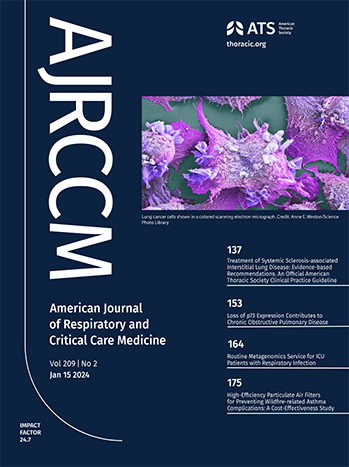支气管扩张的上呼吸道微生物组,纤毛粘膜功能和临床结果:来自EMBARC-BRIDGE研究的数据。
IF 19.4
1区 医学
Q1 CRITICAL CARE MEDICINE
American journal of respiratory and critical care medicine
Pub Date : 2025-09-12
DOI:10.1164/rccm.202504-0875oc
引用次数: 0
摘要
感染是支气管扩张的关键疾病驱动因素,已知上呼吸道微生物组可以塑造下呼吸道微生物组。目的探讨支气管扩张患者上呼吸道微生物群、纤毛粘膜功能与临床预后的关系。方法收集来自欧洲5个中心的344例支气管扩张患者的鼻咽拭子。在1年的随访中,共有104例患者获得了鼻咽样本。根据BSI和严重恶化情况评估微生物组组成。α-和β-多样性分别采用Chao1指数和Bray-Curtis指数测定。进行随机森林分析。生态失调被定义为致病分类群相对丰度为bb0 - 10%,包括假单胞菌、嗜血杆菌和葡萄球菌。在344例患者中,200例(58.1%)为女性(中位年龄68岁,四分位数范围59-75岁)。α-多样性根据疾病严重程度存在显著差异(P=0.002), β-多样性分析显示不同的微生物组谱与疾病严重程度和严重恶化相关(PERMANOVA, P分别=0.021和0.001)。随机森林分析发现假单胞菌与严重支气管扩张(BSI≥9)和严重恶化有关。痰培养中假单胞菌属水平的相对分类丰度与铜绿假单胞菌的生长有良好的相关性。鼻咽生态失调患者的呼吸系统症状更为严重,鼻上皮活检显示上皮破坏,1年随访期间病情加重程度高于非生态失调组。在基线和1年随访期间,微生物组谱相对稳定(P=0.95)。结论上呼吸道微生物组与疾病严重程度及支气管扩张严重加重有关。本文章由计算机程序翻译,如有差异,请以英文原文为准。
Upper Airway Microbiome, Mucociliary Function, and Clinical Outcomes in Bronchiectasis: Data from the EMBARC-BRIDGE Study.
RATIONALE
Infection is a key disease driver in bronchiectasis, and the upper airway microbiome has been known to shape the lower airway microbiome.
OBJECTIVES
To evaluate the relationship between the upper airway microbiome, mucociliary function, and clinical outcomes in bronchiectasis.
METHODS
Nasopharyngeal swabs were collected from 344 bronchiectasis patients enrolled across five European centers. A total of 104 patients had nasopharyngeal samples obtained at the 1-year follow-up. Microbiome composition was assessed according to BSI and severe exacerbations. The α- and β-diversity were measured using the Chao1 and Bray-Curtis indices, respectively. Random forest analysis was performed. Dysbiosis was defined as >10% relative abundance of pathogenic taxa comprising Pseudomonas, Haemophilus, and Staphylococcus.
MEASUREMENTS AND MAIN RESULTS
Of the 344 patients, 200 (58.1%) were female (median age, 68 years; interquartile range, 59-75 years). α-diversity significantly differed according to disease severity (P=0.002), and β-diversity analysis revealed distinct microbiome profiles associated with disease severity and severe exacerbation (PERMANOVA, P=0.021 and 0.001, respectively). Random forest analysis identified Pseudomonas as being associated with severe bronchiectasis (BSI≥9) and severe exacerbations. The genus-level relative taxon abundance of Pseudomonas was well correlated with Pseudomonas aeruginosa growth in the sputum culture. Patients with nasopharyngeal dysbiosis had more severe respiratory symptoms, showed epithelial disruption on nasal epithelial biopsy, and experienced more severe exacerbation over a 1-year follow-up period than those in the non-dysbiosis group. The microbiome profiles were relatively stable between baseline and 1-year follow-up (P=0.95).
CONCLUSION
The upper airway microbiome is associated with disease severity and severe exacerbation of bronchiectasis.
求助全文
通过发布文献求助,成功后即可免费获取论文全文。
去求助
来源期刊
CiteScore
27.30
自引率
4.50%
发文量
1313
审稿时长
3-6 weeks
期刊介绍:
The American Journal of Respiratory and Critical Care Medicine focuses on human biology and disease, as well as animal studies that contribute to the understanding of pathophysiology and treatment of diseases that affect the respiratory system and critically ill patients. Papers that are solely or predominantly based in cell and molecular biology are published in the companion journal, the American Journal of Respiratory Cell and Molecular Biology. The Journal also seeks to publish clinical trials and outstanding review articles on areas of interest in several forms. The State-of-the-Art review is a treatise usually covering a broad field that brings bench research to the bedside. Shorter reviews are published as Critical Care Perspectives or Pulmonary Perspectives. These are generally focused on a more limited area and advance a concerted opinion about care for a specific process. Concise Clinical Reviews provide an evidence-based synthesis of the literature pertaining to topics of fundamental importance to the practice of pulmonary, critical care, and sleep medicine. Images providing advances or unusual contributions to the field are published as Images in Pulmonary, Critical Care, Sleep Medicine and the Sciences.
A recent trend and future direction of the Journal has been to include debates of a topical nature on issues of importance in pulmonary and critical care medicine and to the membership of the American Thoracic Society. Other recent changes have included encompassing works from the field of critical care medicine and the extension of the editorial governing of journal policy to colleagues outside of the United States of America. The focus and direction of the Journal is to establish an international forum for state-of-the-art respiratory and critical care medicine.

 求助内容:
求助内容: 应助结果提醒方式:
应助结果提醒方式:


